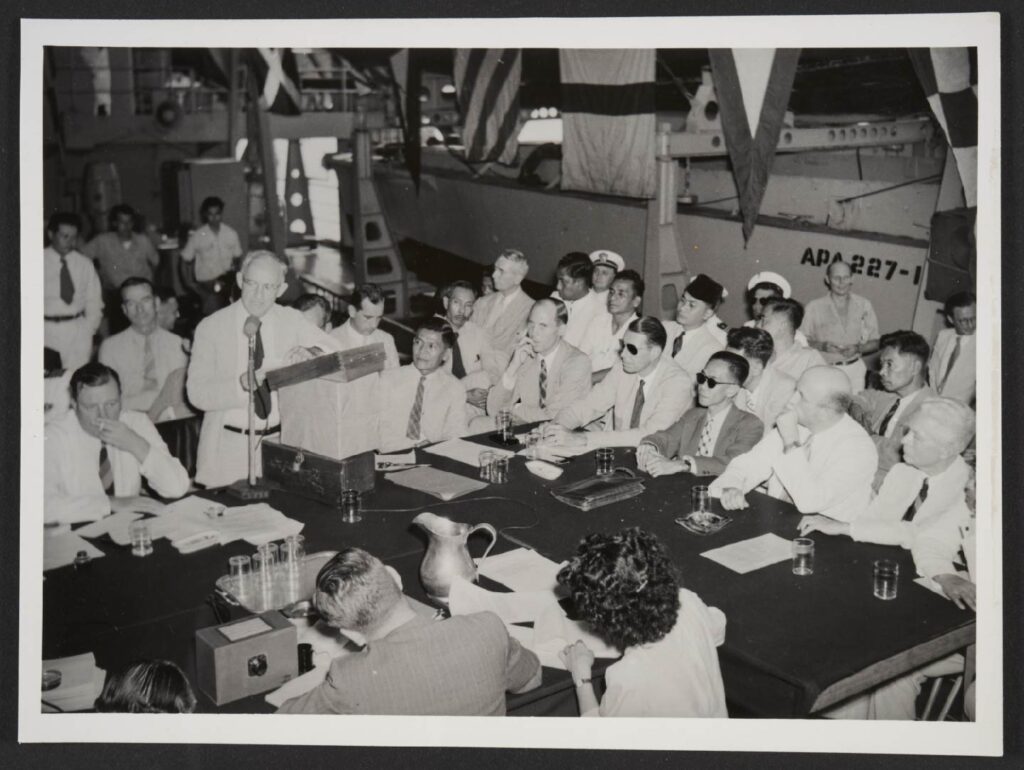The Renville Agreement, January 1948
This page is the seventh of nine in a virtual exhibition on Frank Porter Graham’s role in negotiations for the recognition of Indonesian independence. See the homepage for the exhibition here. See the previous page here. See the next page here.
From the time when the UNC Committee of Good Offices arrived in Indonesia, it sought a neutral site for negotiations between the Dutch and Indonesians. The US Navy made available the USS Renville, anchored in the harbor of Batavia (now Jakarta), as a meeting space in December 1947 and January 1948.[1] (You can read the statement of Frank Porter Graham at the first negotiation aboard the Renville on our website here.) This ship eventually gave its name to the treaty signed by the two sides and supported by the UN Committee, called the Renville Agreement and signed on January 17, 1948.

The beginnings were quite difficult. As Dr. Frank wrote to his wife on December 4, 1947,
Both sides are sensitive and jumpy as must be expected after so many months of a bitter struggle, and both sides are distrustful and sometimes by a carry over include our committee in these distrust and fears. We can tell our side later if necessary. Besides, we are too busy and too committed to a great task to be diverted therefrom from such psychologically natural but groundless importations. Also, I am sure that many of the leaders of both sides of the dispute are men of integrity, good will and intended fairness that with more tranquility in this long disturbed island there better selves will reassert themselves.[2]
The content of the Renville Agreement was an unlikely compromise born of what Dr. Frank called “stubborn hope” to find some small area where the two sides could agree.[3] Throughout the final months of 1947, the Dutch side rejected every political proposal put forward by the Committee of Good Offices, while the Republic had expressed a willingness to accept each of the three successive proposals put forward. In a last-ditch effort, the Committee issued eight political principles on Christmas Day, December 25, 1947. The Dutch shortly responded with twelve alternative principles, significantly less respectful to the Indonesian position, including accepting a ceasefire line that the Dutch had drawn well beyond what they actually controlled and protections for the puppet states being set up with Dutch sponsorship in various parts of the archipelago. With a Dutch ultimatum to accept their principles or face further military action (in violation of a UN ceasefire), the Committee of Good Offices consulted with the Republic of Indonesia urgently and drafted six additional articles to protect the position of the Republic. Dr. Frank was the driving force getting everyone to agree a compromise, because he was worried that any delay by the parties would only advantage the Dutch side. Even a member of the Australian team, Mr. Critchley, had to be convinced that a bad ceasefire line on a quick timeline was more to the benefit of the Indonesians than dragging out negotiations while the Dutch continued to bring in more troops, occupy territory, and set up puppet states.[4]
In the words of a later Indonesian foreign minister,
The [Indonesian] delegation had accepted these agreements under very strong pressure from Dr. Graham, who without doubt had himself acted under pressure from the U.S. State Department.[5]
Although the Renville Agreement was hard-fought by all sides and hard-won by the Committee, it did not resolve all the key issues at the center of the conflict between the Dutch and the Indonesians. It did not even claim to do so! Instead, as one of the American diplomatic aides in the effort later wrote, the Renville Agreement
constituted an attempt to resume political negotiations and as a result of the addition of the [Committee of Good Offices]’s six principles, to ensure that the Republic per se would form one of the States of the [United States of Indonesia], and that the United Nations would remain in the archipelago during the transition period. Seen in this light, the Renville Agreements could be considered as they were by the [Committee] as the ultimate effort to prevent the Basic Issues from being resolved unilaterally [i.e., by Dutch force of arms].[6]
Given such an underwhelming outcome, the politicians who negotiated for the Republic of Indonesia could not convince all their colleagues or especially the leaders of the Indonesian military to respect the compromise—especially on the ceasefire line. The same thing could be said about the Dutch side, which received much grief from the UN Security Council for “mopping up” operations that looked very suspiciously like standard military advances.
In the end, the Renville Agreement held for several months as a treaty, but it was so controversial among Indonesian political elites that it immediately prompted two major parties to withdraw support for the governing coalition, leading to a major cabinet shake-up.
[1] Agung, 36.
[2] Letter from Frank Porter Graham to Marion Graham, December 4, 1947, in the Frank Porter Graham Papers, Wilson Library, UNC-Chapel Hill, folder 1982.
[3] Statement of Sen. Frank Porter Graham on Indonesia, from the Congressional Record of April 5, 1949 (81st Congress, Senate, 95, vol. 3, pp. 3839-3849). Read the full statement on the Carolina Asia Center website here.
[4] Alastair M. Taylor, Indonesian Independence and the United Nations (Ithaca, NY: Cornell University Press, 1960), 82.
[5] Agung, 38.
[6] Taylor, 97.
